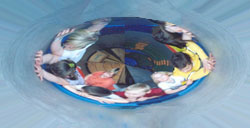The effect of a music/ movement program on preschooler’s motor rhythmic ability
The aim of the present study was to examine the effect of a music/movement program on the motor rhythmic ability of 70 children, aged 48-72 months (59.67+6.38) randomly assigned to experimental (EG, n=36) and control group (CG, n= 34). The EG participated in a 20-week music/movement program, while the CG did not follow any organized physical activity. Before and after the program children’s rhythmic ability was measured using the subtest “Jump on the rhythm” of the Democritus-Psychomotor Assessment Tool for Preschool Children (PAT-PRE). According to the results of the two-way ANCOVA that was implemented, both program and gender had a statistically significant effect on children’s scores (F1,65= 222.24, p< .001, η2= .84 and F1,65= 6.60, p < .05, η2= .09 respectively) after controlling for the effect of the pre-test, while there was not a significant effect of those factors’ interaction. The children of the EG had significantly higher scores than those of the CG, while girls outperformed boys in both groups. However, effect size value of gender was moderate; consequently, these differences were not of practical importance. The current findings provide support for the beneficial effect of a developmentally appropriate music/movement program on rhythmic ability of preschool aged children.
The effect of a music/ movement program on preschooler’s motor rhythmic ability Read More »






